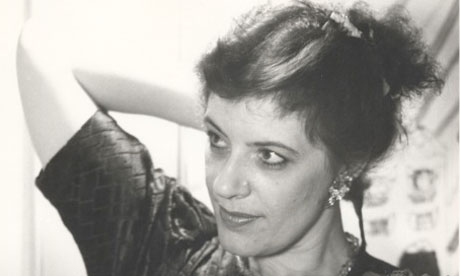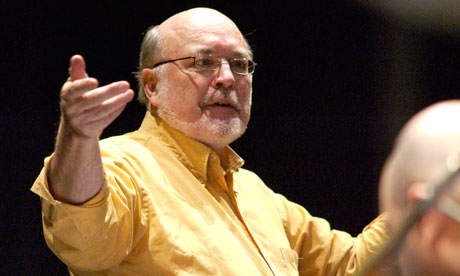
A born subversive, Susan Collier challenged the rules of mechanical patterning
"For 50 years the work of Susan Collier, who has died of cancer aged 72, patterned houses and garments, haute couture and high streets. The most famous patterns are in every textbook as exemplars of the art, and many readers would recognise their mother's curtains, their aunt's scarf and their wedding-present sheets, but be unaware of the partnership of Collier and her sister Sarah Campbell, who created them. Cloth was Collier's medium, and pattern was the way she told a story, conversed, manifested her philosophy, and entered people's visual memories. When her
retrospective exhibition opens at the National theatre later this month, there will be as much of her work on the visitors as on the walls.
She attributed her gifts, including her sensitivity to colour, to her parents: her mother, the actor Patience Collier, who painted Susan's chair the peculiar red and yellow she requested, and gave her paper and brush; and her father, the pharmacologist Harry Collier, who took her on walks to stare hard at nature, spending hours peering at butterfly wings.
Susan was born in Manchester. Wherever they lived, Collier's parents planted flowers, and she was excited by their intense shades. Her formative encounter, aged around five, was with "my lifelong friend Matisse", through a book of reproductions with his name printed in a "fantastic, special blue ink" on its cover. She wanted to be a painter, but "knew I wasn't Matisse". What she could be, she realised when she shopped for fabrics in the department store Derry & Toms, and found them all morose, was a painter of textile designs.
Collier was self-taught, dogsbodying for the freelance designer Pat Albeck and selling her own initial sketches to the scarf brands Richard Allan and Jacq- mar. In 1961, she approached Liberty with a portfolio; if they bought two images, this would be her career. They bought six, and commissioned more.
 Matisse for the masses ... Susan Collier's Côte d'Azur print. Photograph: Collier Campbell
Matisse for the masses ... Susan Collier's Côte d'Azur print. Photograph: Collier Campbell
As a born subversive, she challenged the rules of mechanical patterning, which from block to roller-cylinder print overorganised design, in what she described as a "plonkity-plonk" manner. Her motto was "cheat the repeat". "I was politically motivated to produce beautiful cloth for the mass market," she said. She enjoyed laundering and ironing too, all part of a textile's life-cycle. She wanted her prints to be painterly, the brushmarks left in – visibly hand-created though mass-produced, not an easy effect to achieve through machines. When you see her art work, gouache creamy as custard, thin brush squiggles all over, you hear the indrawn breath of a printer about to say: "Are you sure you want it done like that?"
Liberty retained her from 1968, her speciality being lively blossoms on Tana cotton lawn. She had married a noted pharmacologist, Andrew Herxheimer, in 1961, and they had small children, so she trained up her younger sister Sarah as an assistant. She helped in school holidays, went to art college, and joined her at Liberty in 1968. As the firm approached its centenary in 1975, its prints on natural fibres were perfect for a time when printed cloth was the
fashion, summers of flowers and winters of paisleys. Liberty prints had been produced in limited runs, but when Collier took over as company design consultant in 1971, she determined to supply the wholesale quantities wanted for couturiers' new ready-to-wear collections, and do the same for furnishings.
The sisters also formed the independent Collier Campbell (C-C) studio, their eventual escape in 1977 from life within Liberty: Collier was the ebullient partner, seldom seen in less than seven yards of assorted patterns. They were a co-op and did not specify who did what, but a tranquil rendering of a difficult line was probably Campbell's, while a rose with heart and guts would be Collier's. "Pleasure sliding across the eye" was her intent, and you got an eyeful of C-C everywhere for almost two decades. Yves Saint Laurent had bespoken a range for his launch of off-the-peg collections ("we sang and danced painting the sketches"); Jean Muir and John Bates settled for special colourways; London independents (including Jaeger) mixed and did not match patterns; Bill Gibb used a print the wrong way up.
On a sunny day you could spot the bright graphics of the clothes C-C sold by post, through magazine adverts. When fashion tired of distinctive prints, there were furnishing commissions from Habitat, Marks & Spencer's first home collection (1985), and the US bedding giant Martex. The print Côte d'Azur (a window on the Mediterranean, Matisse for the masses) from a 1983 collection that won a Design Council award, was so ubiquitous worldwide that I used to send Collier postcards from far away recording sightings – as curtains above the Arctic circle, a cushion in Kyoto.
The cards went to her Queen Anne house in Clapham Old Town, which she had bought derelict in 1969 – grass was growing in its basement kitchen – and restored, planting a secret garden at the back. She stayed there until the late 90s, when the formerly dozy local pubs attracted young hordes. The last straw was a drunk girl passing out on her front path, wearing less than a metre of mangy cloth. She sold up and made ambitious gardens for two subsequent south London homes.
The world had changed. C-C were textile converters as well as designers, managing the supply of raw greige fabrics and printing processes, a business that toughened brutally with globalisation. Collier never wanted to be a big-name brand, which she felt meant fewer fresh ideas plastered over ever more objects; C-C did open a short-lived boutique in Mayfair, but it was just as the luxury trade was investing in anything but the small, chic shop. Although the business harshened further, there has seldom been a year without fresh C-C designs, and Collier was working fiercely almost until her death on a range to coincide with the half-century exhibition.
Her marriage to Herxheimer, and a later marriage to the broadcaster Frank Delany, ended in divorce. Sarah, her brother, Joe, daughters, Sophie and Charlotte, and grandchildren survive her."
Written by Veronica Horwell
Source:
http://www.guardian.co.uk/artanddesign/2011/may/15/susan-collier-obituary






